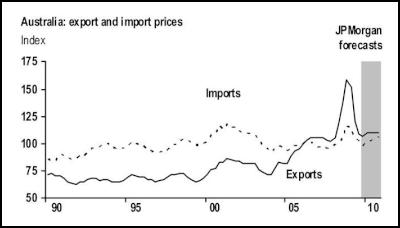Stronger AUD Forces Down Aussie Export And Import
Stronger AUD Forces Down Aussie Export And Import Prices
Click here for the full Note and disclosures.
Export and import prices
Both export and import prices fell in 4Q, the relatively larger fall in import prices causing the terms of trade to rise 3%q/q, after a 7% fall in the previous quarter. The significant 20% annual fall in the terms of trade has put downward pressure on national income growth over 2009.
Export prices fell slightly less than expected, down 1.7%q/q (J.P. Morgan -4%), or by 33%oya in the December quarter. The decline over the quarter mainly owed to lower prices for food and live animals (-5%), machinery and transport equipment (-4%), and miscellaneous manufactured articles (-5.5%). The ABS reported that stronger AUD played an important role in the price declines, as did further falls in the price of key commodities, such as coal, coke and briquettes (-7%), and metalliferous and metal scrap (-2%). Over the year, the continued appreciation of the currency and softer commodities prices have driven the export price index down 33%, the largest fall in 35 years.
The fall in import prices, also owing predominantly to stronger AUD, was larger than the 1%q/q drop we had penciled in. The data, therefore, pushes down our 4Q CPI forecast (data released next Wednesday), although only mildly, from 0.6%q/q to 0.5%q/q on the headline measure. In year-ago terms, headline inflation should print at a relatively benign 2.1%, however the core measure, which we forecast to print at 0.6%q/q, will remain above the RBA’s 2-3% target range at 3.2%oya.
Given the remarkable run of domestic data in recent weeks - consumer confidence recovered all the losses associated with the RBA’s three consecutive rate hikes, the unemployment rate surprisingly fell in December to 5.5%, and retail sales surged by over 1% in November - the probability of a February rate hike has only increased. We continue to forecast a 25bp hike, the stubbornly elevated core inflation we expect at next week’s CPI print will confirm that the Australian economy has not even purged price pressures from the prior boom, before commencing the next upswing. After February, policy should turn more data-dependent, though the general path is clear – we forecast a cash rate of 5% at year-end.

Click to enlarge
ENDS


 PSA: Worker Involvement Critical In Developing AI For The Good Of Aotearoa
PSA: Worker Involvement Critical In Developing AI For The Good Of Aotearoa MBIE: Easter Trading Laws - Your Rights And Responsibilities
MBIE: Easter Trading Laws - Your Rights And Responsibilities The Conversation: As More Communities Have To Consider Relocation, We Explore What Happens To The Land After People Leave
The Conversation: As More Communities Have To Consider Relocation, We Explore What Happens To The Land After People Leave Bill Bennett: Satellite TXT expands, how Egmont Village got a fibre network
Bill Bennett: Satellite TXT expands, how Egmont Village got a fibre network Community Access Media Alliance: Proposed Spectrum Fee Increases Threaten New Zealand’s Community Access Media Sector
Community Access Media Alliance: Proposed Spectrum Fee Increases Threaten New Zealand’s Community Access Media Sector Brewers Association: Brewers Association Of New Zealand Supports Modernisation Of Alcohol Legislation
Brewers Association: Brewers Association Of New Zealand Supports Modernisation Of Alcohol Legislation



